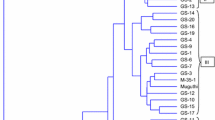Abstract
Collar rot, caused byRhizoctonia solani Kühn, is one of the most severe fungal diseases of opium poppy. In this study, heritability, genetic advance and correlation for 10 agronomic, 1 physiological, 3 biochemical and 1 chemical traits with disease severity index (DSI) for collar rot were assessed in 35 accessions of opium poppy. Most of the economically important characters, like seed and capsule straw yield per plant, oil and protein content of seeds, peroxidase activity in leaves, morphine content of capsule straw and DSI for collar rot showed high heritability as well as genetic advance. Highly significant negative correlation between DSI and seed yield clearly shows that as the disease progresses in plants, seed yield declines, chiefly due to premature death of infected plants aswell as low seed and capsule setting in the survived population of susceptible plants. Similarly, a highly significant negative correlation between peroxidase activity and DSI indicated that marker-assisted selection of disease-resistant plants based on high peroxidase activity would be effective and survived susceptible plants could be removed from the population to stop further spread.
Similar content being viewed by others
References
Allard RW, 1960. Principles of plant breeding. New York: John Wiley and Sons.
Arnon DI, 1949. Copper enzymes in isolated chloroplasts polyphenoloxidase inBeta vulgaris. Plant Physiol 24: 1–15.
Bajpai S, Gupta AP, Gupta MM, Sharma S, Govil CM, Kumar S, 2000. Interrelation between descriptors and morphine yield in Asian germplasm of opium poppyPapaver somniferum. Genet Res Crop Evo 47: 315–322.
Briza J, 1983. The inheritance of seed weight per plant and morphine content in opium poppy. Sbornik Uvtiz Genetika a Slechteni 19: 307–318.
Dubedout M, 1993. Analysis of progenies from a circular plan of crosses in poppy (Papaver somniferum L.). Ph.D. Thesis, Univ of Paris, Orsay: 101.
Fehrmann H, Dimond AE, 1967. Peroxidase activity andPhytophthora resistance in different organs of potato plants. Phytopathology 57: 69–72.
Gupta R, 1984. Improved production method of opium poppy. Indian Hortic 28: 9–12.
Gupta MM, Verma RK, 1996. Combined thin layer chromatography-densitometry method for quantitative estimation of major alkaloids in poppy straw samples. Indian J Pharm Sci 58: 161–162.
Jackson ML, 1973. Soil chemical analysis. Prentice Hall of India Pvt. Ltd. New Delhi.
Johanson HW, Robinson HF, Comstock RE, 1955. Genotypic and phenotypic correlations in soybean and their implication in selections. Agron J 47: 471–483.
Khanna KR, Singh UP, 1975. Correlation studies inPapaver somniferum L. and their bearing on yield improvement. Plant Med 28: 92–96.
Miller PA, Williams VC, Robinson HP, Comstock RC, 1958. Estimates of genotypic and phenotypic environmental variances and covariances in upland cotton and their implications in selection. Agron J 5: 126–136.
Nergiz C, Otles S, 1994. The proximate composition and some minor constituents of poppy seeds. J Sci Food Agric 66: 117–120.
Pant V, Sharma JR, Singh RR, 1999. Genetic assaying of two F2 populations of opium poppy for seed yield and other economic traits. J Med Arom Plant Sci 21: 719–723.
Pant V, Sharma JR, Singh RR, 1999. Genetic characterization of elite genetic stocks of opium poppy for seed yield and other economic traits. J Med Arom Plant Sci 21: 702–708.
Ramanujam S, Triumalachar DK, 1967. Genetic variability of certain characters in red pepper (Capsicum annum L.). Mysore J Agr i Sci 1: 30–36.
Reuveni M, 1998. Relationship between leaf age, peroxidase and B-1,3-glucanase activity and resistance to downy mildew in grapevines. J Phytopath 146: 525–530.
Reuveni R, Shimoni M, Karchi Z, Kue J, 1992. Peroxidase activity as a biochemical marker for resistance of muskmelon (Cucumis melo) toPseudoperonospora cubensis. Phytopathology 82: 749–753.
Reuveni R, Shimoni M, Cute IR, 1991. An association between high peroxidase activity in lettuce (Lactuca sativa) and field resistance to downy mildew (Bremia lactuca).J Phytopathol 132: 312–318.
Sattar A, Dhawan OP, Saini S, Trivedi M, Shahabuddin S, Alam M, 1999. Collar rot a new disease of opium poppy caused byRhizoctonia solani. Indian J Plant Pathol 17: 99–101.
Shannon LM, Kay E, Lew JY, 1966. Peroxidase isozymes from horseradish roots: Isolation and physical properties. J Biol Chem 241: 2166–2172.
Sharma JR, Mishra HO, Lal RK, Srivastava RK, 1992. Intraspecific differentiation in Indian opium poppy,P. somniferum L. Proc Indian Natn Sci Acad B58: 147–152.
Shukla S, Khanna KR, 1987. Genetic association in opium poppy. Indian J Agric Sci 57: 147–151.
Singh SP, Khanna KR, 1991. Heterosis in opium poppy (Papaver somniferum L.). Narendra Deva J Agric Res 6: 88–92.
Singh SP, Shukla S, Khanna KR, 1995. Opium poppy: Advances in Horticulture, Medicinal and Aromatic Plants. In: Chadha KL, Gupta R, eds. Malhotra Publications. New Delhi, India 11: 535–574.
Tiwari RK, Singh SP, Dubey T, 2000. Correlations in opium poppy and their implication in selection. J Med Arom Plant Sci 22: 264–276.
Trivedi Mala, Shahabuddin S, Sattar A, Alam A, Dhawan OP, 2001. Screening of opium poppy germplasm for disease resistance against collar rot caused byRhizoctonia solani. Indian J Plant Pathol 19: 94–96.
Trivedi Mala, Dhawan OP, Tiwari RK, Sattar A, 2005. Genetic studies for collar rot resistance in opium poppy (Papaver somniferum L.). J Appl Genet 46: 279–284.
Webber CR, Moorthy BR, 1952. Heritable and non-heritable relationship and variability of oil content and agronomic characters in F2 generation of soybean crosses. Agron J 44: 202–209.
Author information
Authors and Affiliations
Corresponding author
Rights and permissions
About this article
Cite this article
Trivedi, M., Tiwari, R.K. & Dhawan, O.P. Genetic parameters and correlations of collar rot resistance with important biochemical and yield traits in opium poppy (Papaver somniferum L.). J Appl Genet 47, 29–38 (2006). https://doi.org/10.1007/BF03194596
Received:
Accepted:
Issue Date:
DOI: https://doi.org/10.1007/BF03194596




